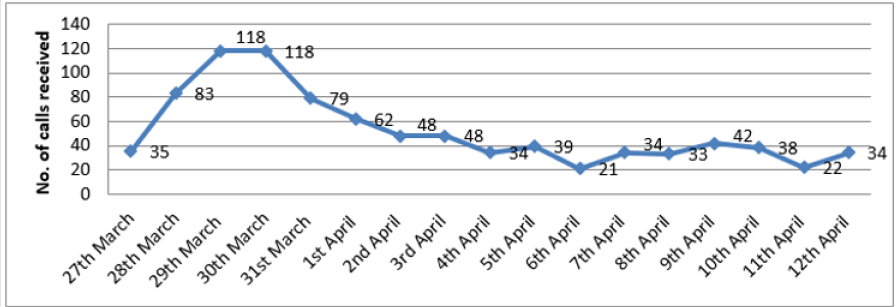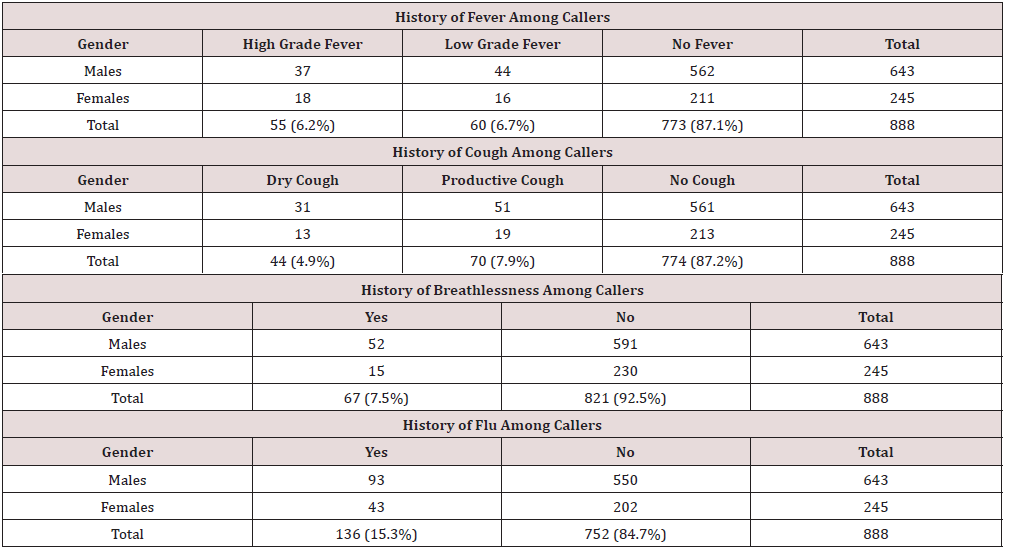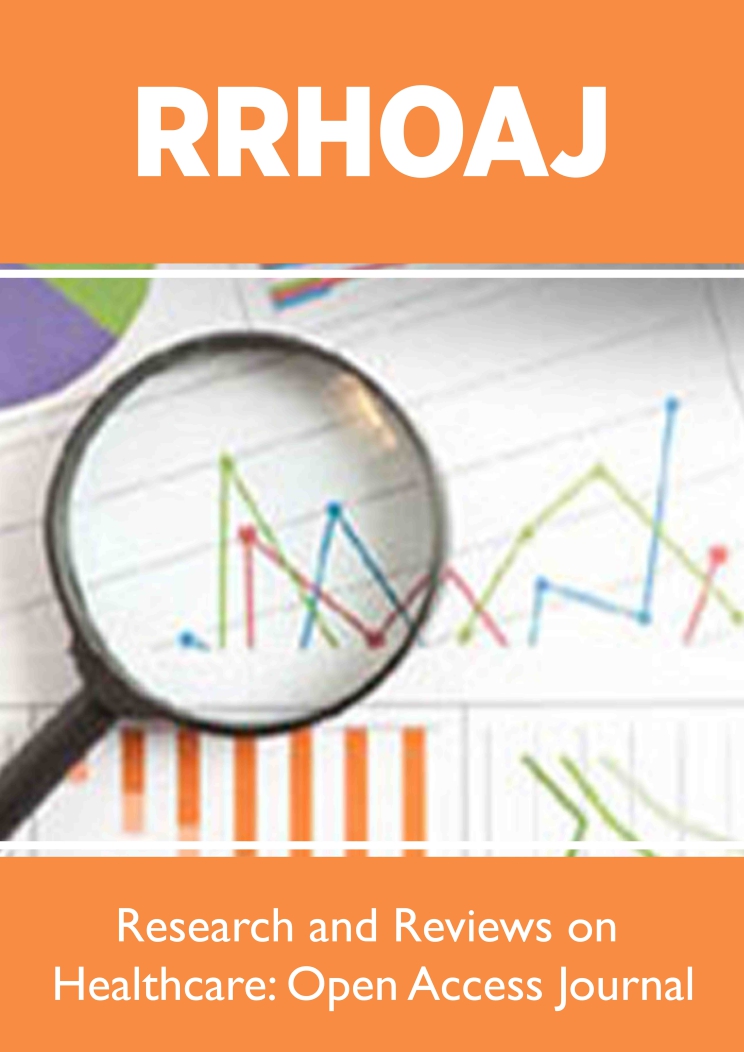
Lupine Publishers Group
Lupine Publishers
Menu
ISSN: 2637-6679
Research Article(ISSN: 2637-6679) 
Telemedicine Services at Rawalpindi Medical University: An Initiative to Optimize Healthcare of the Patients During COVID-19 Pandemic Volume 5 - Issue 3
Rizwana Shahid*, Muhammad Umar, Shazia Zeb, Naeem Akhtar, Syed Muhammad Ali, Syed Iqbal Haider, Narjis Zaidi, Muhammad Ahmed and Hassan Ahmad
- Rawalpindi Medical University, Pakistan
Received: May 08, 2020; Published: May 27, 2020
Corresponding author: Rizwana Shahid, Rawalpindi Medical University, Pakistan
DOI: 10.32474/RRHOAJ.2020.05.000211
Abstract
Objectives: To counsel the patients about COVID-19 pandemic and address their general and comorbid health problems by recommending appropriate referrals at their doorsteps. This will minimize the probability of viral transmission by limiting patients’ visits to healthcare facilities.
Methods: A survey was carried out at Rawalpindi Medical University to determine the presenting complaints of public calling at telemedicine center which was formulated amid COVID-19 pandemic since 27th March 2020. Doctors along with support staff worked at telemedicine center in three shifts twenty four hours via free dedicated helpline number. A questionnaire along with scoring sheet was formulated and provided to our doctors at telemedicine center so that they can categorize the callers as suspects or healthy people based on the scoring which they determine of patient. The data was gathered pertinent to demographics, symptoms (cough, flu, fever, breathlessness, and general problems) contact and travel history. Different referral numbers (1166, 1122 and 1033) were also communicated to the people with respective attributes. The data was analyzed by using SPSS version 25 .0.
Results: Total 888 public calls were received at the telemedicine center via mobile phones as well as video links established at the telemedicine center. Among callers 643 and 245 were males and females, respectively. Majority of the callers (22%) were 21- 30 years of age. About 6.2% callers had high grade fever, 4.9% had dry cough, 7.5% complained of shortness of breath and 15.3% had history of flu. Of the 13 callers with history of international travel, none of them had dry cough and high grade fever but still they were quarantined for about 14 days. Out of 7 callers with history of contact with infected person, only 2 were hospitalized while rest of the 5 isolated at home. Total 29 callers being suspects were referred to specified helpline numbers for testing, corona virus infection confirmation and emergency help while 31 callers were facilitated in food provision on demand due to lockdown imposition.
Conclusion: Telemedicine is determined to be the best utilization of technology for healthcare management of patients with maintenance of social distancing and at the same time counseling for adoption of precautionary measures amid COVID-19 pandemic. In addition to referring the suspects, confirmed cases and medical emergencies to helplines, this technology also serves to cater the food scarcity among needy people resulting from lockdown situation.
Keywords: Telemedicine; COVID-19 Pandemic; Viral transmission; Healthcare; Suspects; Corona virus infection
Introduction
COVID-19 is very distressing to the whole world as increased vulnerability of the human population to the novel corona virus has severely affected national and international traveling and other daily routine activities. Unlike SARS 2003 and MERS 2012 outbreaks, COVID-19 pandemic is more devastating in terms of rapid spread and profound contribution towards high mortality and social unrest [1]. World Health Organization has categorized COVID-19 as pandemic [2]. Patients with co-morbidities and immune-deficiencies are more susceptible to corona virus infection [3]. It is feasible for the patients to get their health problems resolved at home through telephonic and video consultation with experts especially during outbreaks as it minimizes the chances of contact with infected people. This methodology has become promising in modern days by the application of telemedicine services in various health plans [4]. Likewise, other historic emerging and re-emerging infectious diseases, corona virus infection has also come up with solutions despite of frequent challenges. This disaster has given an insight to our healthcare professionals for continuation of healthcare services through adoption of telemedicine. This technology will certify optimal healthcare services delivery to the general population with minimal transmission of infection [5]. High load of transmissible infection has provoked attention towards Telemedicine as the need of time [6]. Governor of Punjab Chaudhry Sarwar and Chief Minister Punjab Sardar Usman Buzdar initiated the free helpline number in multiple medical universities of the province to facilitate the public in resolution of their health problems at their doorsteps [7]. Member of Provincial Assembly (MPA) Raja Rashid Hafeez were deputed to monitor the telemedicine services offered at different medical institutes of Rawalpindi city. Prof. Muhammad Umar, Vice Chancellor of Rawalpindi Medical University (RMU) along with his dedicated team started telemedicine in response to COVID-19 at Holy Family Hospital on 27th March 2020 that is one of the teaching hospitals of this University. This telemedicine center is a part of chain of telemedicine centers instituted all over the Punjab comprising of 150 mobile phone lines through free UAN Calling number (0304-1112101) and video consultation via a web portal “doctors247.online” [8]. A fully operational digital infrastructure with broadband internet set up was installed for smooth functioning and integrity of telemedicine. So, in addition to video consultancy with qualified doctors round the clock, patients’ counseling through voice call was also enabled to assist the public who were devoid of internet services at their residence. The telemedicine service initiated at Holy Family Hospital, Rawalpindi are intended not only to identify the COVID-19 patients, guide for prevention and refer suspects but also to manage other health related issues faced during current lockdown scenario. Use of standard scoring sheet by doctors to score the problems of calling patients facilitated in apt referral. Hence, this technology of distant healthcare management exceedingly lessened the risk of viral transmission.
Subjects & Methods
A survey was carried out to scrutinize the symptoms of public calling at telemedicine center initiated in wake of COVID-19 pandemic on 27th March 2020 at Rawalpindi Medical University. Survey was done by using a list of questions along with scoring sheet to label the callers as suspects or healthy individuals. Duty rosters of doctors as well as computer operators and support staff were prepared to ensure services provision round the clock in morning, evening and night shifts through a free helpline number. Assistant Professors of Basic Sciences at Rawalpindi Medical University were assigned the duty of Shift In charge. The data was collected pertinent to demographics (age, gender, address, CNIC No.) symptoms (cough, flu, fever, breathlessness, and general problems) in addition to travel history and contact with infected person. Contact numbers of helping organization were enlisted to help needy people suffering from food scarcity in response to lockdown imposed amid COVID-19 pandemic. The outcomes were measured in terms of number of callers presenting with symptoms of COVID-19 with score enough to label them as suspects. Different referral numbers (1166, 1122 and 1033) were also communicated to the suspects, people with any medical emergency and confirmed COVID-19 cases for facilitation of medical care. The data was analyzed by using SPSS version 25 .0.
Results
Total 888 public calls received by our doctors via mobile phones as well as video links in telemedicine center established at Rawalpindi Medical University (RMU) on free helpline number assigned by the Punjab Government amid COVID-19 pandemic from 27th March 2020 to 12th April 2020 as depicted below in Figure 1. Number of public calls received on each station during each shift by our assigned doctors is reflected below in Table 1. Of the total 888 callers, 643 were males while 245 were females. Majority of callers were in 21-30 years age group as shown below in Figure 2. Presenting complaints of callers listened and catered accordingly at telemedicine center of RMU are depicted below in Table 2. About 13 callers gave history of international visit during last 14 days but none of them had dry cough. Even none of the international travelers had high grade fever and only 02 of them had flu without any other associated symptoms. These callers quarantined themselves for longest incubation period of diseases (about 14 days). Analgesics, anti-pyretic and mild cough suppressants were recommended by our duty doctors for symptomatic relief. Only 06 male and 01 female caller gave history of contact with corona virus infected cases out of which 01 male and 01 female were admitted in hospital while rest of them were isolated at home. Some emergency call numbers were also specified and disseminated through social media for immediate referral of the cases or suspects and to arrest the crisis amid COVID-19 pandemic in Pakistan. These were 1166, 1122 and 1033 for COVID-19 testing, emergency help and home visit by concerned team for corona virus infection confirmation, respectively. Callers having score of their health problem above 3 were referred to 1166 for PCR test and hence diagnosis of their health problem by collection of nasopharyngeal and throat swabs by respective team. Those with any sort of health urgency at home were referred to 1122 for timely healthcare management by provision of ambulance. People having PCR test positive for corona virus infection were referred to 1033 so that assigned officers can get confirmation of test by visiting the patients’ home. About 20 callers had score 3 and above according to corona scoring system based on their symptoms and were referred to 1166 for testing as depicted in Table 3. About 23 males and 08 females called for food provision due to food shortage in response to lockdown imposition in Pakistan during COVID-19 pandemic.
Table 1: Station-wise calls received during each shift amid COVID-19 pandemic at RMU telemedicine center.

Table 3: Age distribution of suspects, emergencies and confirmed COVID-19 cases referred to help lines.

Discussion
Telemedicine services are of great significance in continuation
of healthcare delivery in response to outbreak of infectious diseases
worldwide. They not only lessen the dissemination of infection
among people by avoidance of crowding in healthcare settings but
also facilitate provision of needful information for containment
[9]. With the advent of wireless broadband technology, healthcare
consultation through voice calls and video consultations has
resulted in two way comfort [10]. Telemedicine is primarily
meant to manage the cases distantly. It is not only anticipated to
manage healthcare by recommending appropriate therapy but also
intended for health promotion, education and disease surveillance
[11]. In current study, commencement of telemedicine services at
Rawalpindi Medical University was aimed to pay attention to all
the general problems and chronic diseases of public in addition to
their health concerns pertinent to COVID-19. Attributes, presenting
complaints, travel and contact history of the callers were listened to
and noted clearly not only for record keeping but also to analyze the
gravity of trouble faced by public amid COVID-19 pandemic. Risk of
corona virus infection among callers was also scored in accordance
with a standardized scoring sheet for appropriate referrals. Voice
calls and video consultation facilitated our doctors in segregation
of the cases and apt counseling. Likewise, telemedicine counters
were also setup in America to mitigate the risk of infection among
patients and healthcare professionals. In addition to history taking,
there were also opportunities to assess the vitals of the patients
before prescribing drugs. Their consultants also determined the
suspects for COVID-19 testing [3]. The World Health Organization
has recognized the significance of telemedicine services in
strengthening health system response to COVID-19 pandemic. This
facet is basically meant to satisfy the healthcare needs of public in
this grave scenario with available healthcare workers. Outbreaks are
assumed to hassle the healthcare system of any region. Apart from
fulfilling essential health needs in outbreaks, health professionals
are also confronted with the burden of managing infectious cases
that contribute to avertable mortality. The only way out under such
unavoidable circumstances is to set up telemedicine platform for
optimization of healthcare [12]. Even Centre for Disease Control
and Prevention has declared the obligation of telemedicine to
manage healthcare of the patients amid COVID-19 pandemic [13].
Similar to the benefits of telemedicine services realized in our
region, telemedicine amenities were also verified to be advantageous
internationally for both public and health workers specifically
in Italy where hospitals were labeled to be as mainstream for
transmission of COVID-19. Consultation of presenting complaints
with doctors through video links and smart phones were confirmed
to aid greatly in lessening the transmissibility of infection [14].
Despite the WHO declaration about COVID-19 as Public Health
Emergency of International Concern (PHEIC) [15], people are
not paying attention to the serious consequences of this havoc.
In our study, about 13 callers with history of international travel
responsibly quarantined themselves. Increased surge of COVID-19
cases has been reported in Iran, Italy, South Korea, Algeria and Gulf
countries which is primarily attributed to visits across borders [16]. Despite the lockdown imposition, people continue roaming
unnecessarily. However, punitive actions were taken by concerned
authorities of some countries against people not staying at home
and hiding history of international travel amid COVID-19 pandemic
[17]. This governmental approach adopted by most of the countries
is surely very effective to tackle the problem intelligently. Although
telemedicine proved beneficial in healthcare provision during
lockdown and managed to reduce workload on health facilities,
but one problem faced globally in perspective of telemedicine was
difficulty in management of serious health conditions that could not
simply be managed without hospitalization. Telemedicine services
therefore demand modification in terms of diagnostic facilities
and triage for those patients who necessitate inpatient care [18].
Telemedicine amenities should periodically be updated for timely
provision of diagnostic and triage services to mitigate the risk of
infection during future epidemics [19].
Conclusion
Leveraging telemedicine in health sciences institutes is of paramount significance specifically during catastrophic situations for continuity of healthcare. International travelers were aware of the significance of the quarantine as need of time. Apart from health care, other real life issues can better be addressed in telemedicine through adequate counseling and facilitation.
References
- Gates B (2020) Responding to COVID-19-A once-in-a-century pandemic? M Engl J Med.
- Novel Coronavirus (2019-nCoV). Situation Reports.
- Portnoy J, Waller M, Elliott T (2020) Telemedicine in the era of COVID-19. J Allergy ClinImmunolPract 8(5): 1489-1491.
- Lacktman N, Rosen D (2017) Telemedicine and Digital Health Survey. Foley & Lardner LLP.
- Chauhan V, Galwankar S, Arquilla B, Garg M (2020) Novel Coronavirus (COVID-19): Leveraging telemedicine to optimize care while minimizing exposures and viral transmission. Journal of Emergencies, Trauma and Shock 13(1):20-24.
- Sylvia Romm MD (2019) Telemedicine emerging as a first line of defense during flu season. Physicians Practice.
- The NEWS. Telemedicine corona helpline offers free medical advice in Pakistan.
- Telemedicine center set up at Holy Family Hospital to combat COVID-19.
- Rockwell KL, Gilroy AS (2020) Incorporating Telemedicine as part of COVID-19 outbreak response systems. The American Journal of Managed Care 26(4):147-148.
- History of Telemedicine md Portal [Internet]. md Portal. 2015 [cited 2018 Dec 02].
- Chellaiyan VG, Nirupama AY, Taneja N (2019) Telemedicine in India: Where do we stand? Journal of Family Medicine and Primary Care 8(6):1872-1876.
- World Health Organization. Strengthening the Health systems response to COVID-19.
- Steps healthcare facilities can take now to prepare for Coronavirus disease 2019 (COVID-19).
- Telemedicine is essential amid the COVID-19 crisis and after it.
- Cascella M, Rajnik M, Cuomo A, Dulebohn SC, Napoli RD (2020) Features, Evaluation and Treatment Coronavirus (COVID-19). StatPearls.
- Novel Coronavirus (2019-nCoV) Situation Reports.
- Coronavirus carrier faces jail in Singapore for lying over movements.
- Healthcare IT News. Telemedicine during COVID-19: Benefits, limitations, burdens, adaptations.
- Doshi A, Platt Y, Dressen JR, Mathews BK, Siy JC (2020) Keep calm and log on: Telemedicine for COVID-19 pandemic response.Journal of Hospital Medicine 15(5): 302-304.

Top Editors
-

Mark E Smith
Bio chemistry
University of Texas Medical Branch, USA -

Lawrence A Presley
Department of Criminal Justice
Liberty University, USA -

Thomas W Miller
Department of Psychiatry
University of Kentucky, USA -

Gjumrakch Aliev
Department of Medicine
Gally International Biomedical Research & Consulting LLC, USA -

Christopher Bryant
Department of Urbanisation and Agricultural
Montreal university, USA -

Robert William Frare
Oral & Maxillofacial Pathology
New York University, USA -

Rudolph Modesto Navari
Gastroenterology and Hepatology
University of Alabama, UK -

Andrew Hague
Department of Medicine
Universities of Bradford, UK -

George Gregory Buttigieg
Maltese College of Obstetrics and Gynaecology, Europe -

Chen-Hsiung Yeh
Oncology
Circulogene Theranostics, England -
.png)
Emilio Bucio-Carrillo
Radiation Chemistry
National University of Mexico, USA -
.jpg)
Casey J Grenier
Analytical Chemistry
Wentworth Institute of Technology, USA -
Hany Atalah
Minimally Invasive Surgery
Mercer University school of Medicine, USA -

Abu-Hussein Muhamad
Pediatric Dentistry
University of Athens , Greece

The annual scholar awards from Lupine Publishers honor a selected number Read More...

.png)





